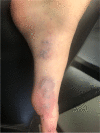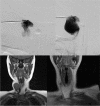Results of interventional treatment of peripheral slow-flow malformations
- PMID: 36763217
- PMCID: PMC9918669
- DOI: 10.1186/s42155-023-00352-3
Results of interventional treatment of peripheral slow-flow malformations
Abstract
Background: In recent years sclerotherapy has increasingly become the treatment of choice for peripheral slow-flow malformations. However, the long-term effectiveness of sclerotherapy is still a matter of debate, especially when it comes to new sclerosing agents like polidocanol. This study aims at gathering further information concerning its long-term effectiveness and safety.
Results: Most patients reported a reduction of symptoms which include pain (57,7%), swelling (65,4%) and functional impairment (60%). Cosmetic complaints were less likely to be reduced by sclerotherapy (44,4%). In most cases a relief of symptoms was stable for many years, especially after several consecutive treatment sessions. Complication rates were comparably low, with only 2 patients requiring additional treatment at hospital and no lasting damages. (…) (7) Most patients (70,9%) were at least partially satisfied with the treatment. Satisfaction was closely linked to a partial or complete relief of symptoms (p = 0.001).
Conclusion: Sclerotherapy is a promising way of treating slow-flow-malformations. Polidocanol has proved to be a save sclerosing agent. The reduction of major symptoms was substantial in most cases and lasted for many years.
Keywords: Embolization; Intervention; Peripheral malformations; Slow flow.
© 2023. The Author(s).
Conflict of interest statement
There are no competing interests.
Figures







Similar articles
-
Craniofacial venous malformations treated by percutaneous sclerotherapy using polidocanol: a single-center experience.Acta Radiol. 2019 May;60(5):593-601. doi: 10.1177/0284185118795326. Epub 2018 Aug 15. Acta Radiol. 2019. PMID: 30111191
-
Treatment of low-flow vascular malformations by ultrasound-guided sclerotherapy with polidocanol foam: 24 cases and literature review.Eur J Vasc Endovasc Surg. 2011 Mar;41(3):412-7. doi: 10.1016/j.ejvs.2010.10.009. Epub 2010 Dec 15. Eur J Vasc Endovasc Surg. 2011. PMID: 21111641 Review.
-
Safety and effectiveness of percutaneous sclerotherapy for venous disorders of the labia majora in patients with vascular malformations.J Vasc Surg Venous Lymphat Disord. 2020 Nov;8(6):1083-1089. doi: 10.1016/j.jvsv.2020.01.008. Epub 2020 Mar 19. J Vasc Surg Venous Lymphat Disord. 2020. PMID: 32199800
-
Safety and efficacy of foam sclerotherapy for treatment of low-flow vascular malformations in children.J Vasc Surg Venous Lymphat Disord. 2020 Nov;8(6):1074-1082. doi: 10.1016/j.jvsv.2019.11.023. Epub 2020 Apr 10. J Vasc Surg Venous Lymphat Disord. 2020. PMID: 32284312
-
Sclerotherapy in venous malformation.Phlebology. 2013 Mar;28 Suppl 1:188-91. doi: 10.1177/0268355513477282. Phlebology. 2013. PMID: 23482557 Review.
References
LinkOut - more resources
Full Text Sources
